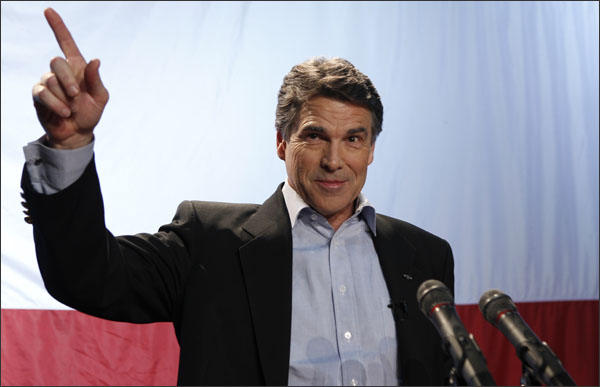Governor Rick Perry of Texas has announced a plan, which he outlines in today’s Wall Street Journal, to replace the corrupt and inefficient internal revenue code with a flat tax. Let’s review his proposal, using the principles of good tax policy as a benchmark.
1. Does the plan have a low, flat rate to minimize penalties on productive behavior?
Governor Perry is proposing an optional 20 percent tax rate. Combined with a very generous allowance (it appears that a family of four would not pay tax on the first $50,000 of income), this means the income tax will be only a modest burden for households. Most important, at least from an economic perspective, the 20-percent marginal tax rate will be much more conducive to entrepreneurship and hard work, giving people more incentive to create jobs and wealth.
2. Does the plan eliminate double taxation so there is no longer a tax bias against saving and investment?
The Perry flat tax gets rid of the death tax, the capital gains tax, and the double tax on dividends. This would significantly reduce the discriminatory and punitive treatment of income that is saved and invested (see this chart to understand why this is a serious problem in the current tax code). Since all economic theories – even socialism and Marxism – agree that capital formation is key for long-run growth and higher living standards, addressing the tax bias against saving and investment is one of the best features of Perry’s plan.
3. Does the plan get rid of deductions, preferences, exemptions, preferences, deductions, loopholes, credits, shelters, and other provisions that distort economic behavior?
A pure flat tax does not include any preferences or penalties. The goal is to leave people alone so they make decisions based on what makes economic sense rather than what reduces their tax liability. Unfortunately, this is one area where the Perry flat tax falls a bit short. His plan gets rid of lots of special favors in the tax code, but it would retain deductions (for those earning less than $500,000 yearly) for charitable contributions, home mortgage interest, and state and local taxes.
As a long-time advocate of a pure flat tax, I’m not happy that Perry has deviated from the ideal approach. But the perfect should not be the enemy of the very good. If implemented, his plan would dramatically boost economic performance and improve competitiveness.
That being said, there are some questions that need to be answered before giving a final grade to the plan. Based on Perry’s Wall Street Journal column and material from the campaign, here are some unknowns.
1. Is the double tax on interest eliminated?
A flat tax should get rid of all forms of double taxation. For all intents and purposes, a pure flat tax includes an unlimited and unrestricted IRA. You pay tax when you first earn your income, but the IRS shouldn’t get another bite of the apple simply because you save and invest your after-tax income. It’s not clear, though, whether the Perry plan eliminates the double tax on interest. Also, the Perry plan eliminates the double taxation of “qualified dividends,” but it’s not clear what that means.
2. Is the special tax preference for fringe benefits eliminated?
One of the best features of the flat tax is that it gets rid of the business deduction for fringe benefits such as health insurance. This special tax break has helped create a very inefficient healthcare system and a third-party payer crisis. It is unclear, though, whether this pernicious tax distortion is eliminated with the Perry flat tax.
3. How will the optional flat tax operate?
The Perry plan copies the Hong Kong system in that it allows people to choose whether to participate in the flat tax. This is attractive since it ensures that nobody can be disadvantaged, but how will it work? Can people switch back and forth every year? Is the optional system also available to all the small businesses that use the 1040 individual tax system to file their returns?
4. Will businesses be allowed to “expense” investment expenditures?
The current tax code penalizes new business investment by forcing companies to pretend that a substantial share of current-year investment outlays take place in the future. The government imposes this perverse policy in order to get more short-run revenue since companies are forced to artificially overstate current-year profits. A pure flat tax allows a business to “expense” the cost of business investments (just as they “expense” workers wages) for the simple reason that taxable income should be defined as total revenue minus total costs.
Depending on the answers to these questions, the grade for Perry’s flat tax could be as high as A- or as low as B. Regardless, it will be a radical improvement compared to the current tax system, which gets a D- (and that’s a very kind grade).
Here’s a brief video for those who want more information about the flat tax.
[youtube nhUOpNve1bY]
Last but not least, I’ve already receive several requests to comment on how Perry’s flat tax compares to Cain’s 9-9-9 plan.
At a conceptual level, the plans are quite similar. They both replace the discriminatory rate structure of the current system with a low rate. They both get rid of double taxation. And they both dramatically reduce corrupt loopholes and distortions when compared to the current tax code.
All things considered, though, I prefer the flat tax. The 9-9-9 plan combines a 9 percent flat tax with a 9 percent VAT and a 9 percent national sales tax, and I don’t trust that politicians will keep the rates at 9 percent.
The worst thing that can happen with a flat tax is that we degenerate back to the current system. The worst thing that happens with the 9-9-9 plan, as I explain in this video, is that politicians pull a bait-and-switch and America becomes Greece or France.

COMMENTS
Please let us know if you're having issues with commenting.